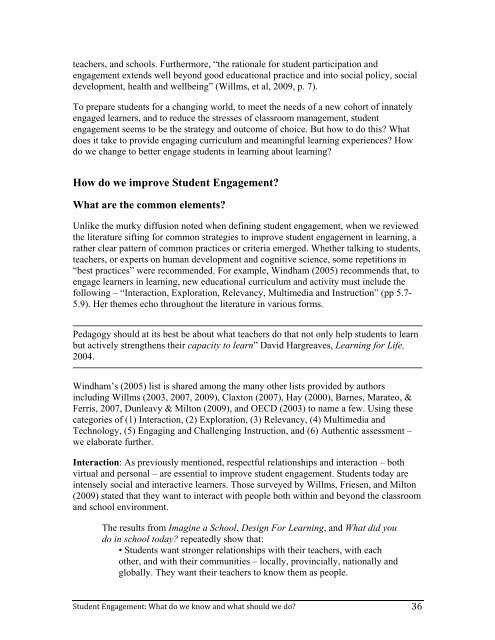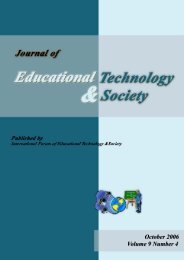Student Engagement: What do we know and what should we do?
Student Engagement: What do we know and what should we do?
Student Engagement: What do we know and what should we do?
Create successful ePaper yourself
Turn your PDF publications into a flip-book with our unique Google optimized e-Paper software.
teachers, <strong>and</strong> schools. Furthermore, “the rationale for student participation <strong>and</strong><br />
engagement extends <strong>we</strong>ll beyond good educational practice <strong>and</strong> into social policy, social<br />
development, health <strong>and</strong> <strong>we</strong>llbeing” (Willms, et al, 2009, p. 7).<br />
To prepare students for a changing world, to meet the needs of a new cohort of innately<br />
engaged learners, <strong>and</strong> to reduce the stresses of classroom management, student<br />
engagement seems to be the strategy <strong>and</strong> outcome of choice. But how to <strong>do</strong> this? <strong>What</strong><br />
<strong>do</strong>es it take to provide engaging curriculum <strong>and</strong> meaningful learning experiences? How<br />
<strong>do</strong> <strong>we</strong> change to better engage students in learning about learning?<br />
How <strong>do</strong> <strong>we</strong> improve <strong>Student</strong> <strong>Engagement</strong>?<br />
<strong>What</strong> are the common elements?<br />
Unlike the murky diffusion noted when defining student engagement, when <strong>we</strong> revie<strong>we</strong>d<br />
the literature sifting for common strategies to improve student engagement in learning, a<br />
rather clear pattern of common practices or criteria emerged. Whether talking to students,<br />
teachers, or experts on human development <strong>and</strong> cognitive science, some repetitions in<br />
“best practices” <strong>we</strong>re recommended. For example, Windham (2005) recommends that, to<br />
engage learners in learning, new educational curriculum <strong>and</strong> activity must include the<br />
following – “Interaction, Exploration, Relevancy, Multimedia <strong>and</strong> Instruction” (pp 5.7-<br />
5.9). Her themes echo throughout the literature in various forms.<br />
Pedagogy <strong>should</strong> at its best be about <strong>what</strong> teachers <strong>do</strong> that not only help students to learn<br />
but actively strengthens their capacity to learn” David Hargreaves, Learning for Life,<br />
2004.<br />
Windham’s (2005) list is shared among the many other lists provided by authors<br />
including Willms (2003, 2007, 2009), Claxton (2007), Hay (2000), Barnes, Marateo, &<br />
Ferris, 2007, Dunleavy & Milton (2009), <strong>and</strong> OECD (2003) to name a few. Using these<br />
categories of (1) Interaction, (2) Exploration, (3) Relevancy, (4) Multimedia <strong>and</strong><br />
Technology, (5) Engaging <strong>and</strong> Challenging Instruction, <strong>and</strong> (6) Authentic assessment –<br />
<strong>we</strong> elaborate further.<br />
Interaction: As previously mentioned, respectful relationships <strong>and</strong> interaction – both<br />
virtual <strong>and</strong> personal – are essential to improve student engagement. <strong>Student</strong>s today are<br />
intensely social <strong>and</strong> interactive learners. Those surveyed by Willms, Friesen, <strong>and</strong> Milton<br />
(2009) stated that they want to interact with people both within <strong>and</strong> beyond the classroom<br />
<strong>and</strong> school environment.<br />
The results from Imagine a School, Design For Learning, <strong>and</strong> <strong>What</strong> did you<br />
<strong>do</strong> in school today? repeatedly show that:<br />
• <strong>Student</strong>s want stronger relationships with their teachers, with each<br />
other, <strong>and</strong> with their communities – locally, provincially, nationally <strong>and</strong><br />
globally. They want their teachers to <strong>know</strong> them as people.<br />
<strong>Student</strong> <strong>Engagement</strong>: <strong>What</strong> <strong>do</strong> <strong>we</strong> <strong>know</strong> <strong>and</strong> <strong>what</strong> <strong>should</strong> <strong>we</strong> <strong>do</strong>? 36












